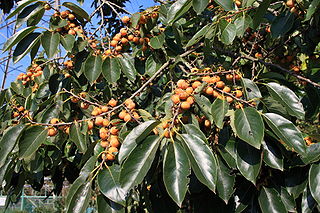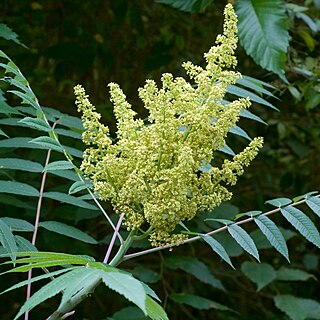
Ulmus glabraHudson, the wych elm or Scots elm, has the widest range of the European elm species, from Ireland eastwards to the Ural Mountains, and from the Arctic Circle south to the mountains of the Peloponnese and Sicily, where the species reaches its southern limit in Europe; it is also found in Iran. A large deciduous tree, it is essentially a montane species, growing at elevations up to 1,500 m (4,900 ft), preferring sites with moist soils and high humidity. The tree can form pure forests in Scandinavia and occurs as far north as latitude 67°N at Beiarn in Norway. It has been successfully introduced as far north as Tromsø and Alta in northern Norway (70°N). It has also been successfully introduced to Narsarsuaq, near the southern tip of Greenland (61°N).

Hesperocyparis arizonica, the Arizona cypress, is a North American species of tree in the cypress family Cupressaceae, native to the southwestern United States and Mexico. Populations may be scattered rather than in large, dense stands.

Diospyros lotus, with common names date-plum,Caucasian persimmon, or lilac persimmon, is a widely cultivated species of the genus Diospyros, native to temperate Asia and southeast Europe. Its English name derives from the small fruit, which have a taste reminiscent of both plums and dates. It is among the oldest plants in cultivation.

Ulmus laciniata(Trautv.) Mayr, known variously as the Manchurian, cut-leaf, or lobed elm, is a deciduous tree native to the humid ravine forests of Japan, Korea, northern China, eastern Siberia and Sakhalin, growing alongside Cercidiphyllum japonicum, Aesculus turbinata, and Pterocarya rhoifolia, at elevations of 700–2200 m, though sometimes lower in more northern latitudes, notably in Hokkaido.

Rhus glabra, the smooth sumac, is a species of sumac in the family Anacardiaceae, native to North America, from southern Quebec west to southern British Columbia in Canada, and south to northern Florida and Arizona in the United States and Tamaulipas in northeastern Mexico.

Hesperocyparis glabra, known as the Arizona smooth bark cypress or smooth Arizona cypress, is a conifer native to the American Southwest, with a range stretching over the canyons and slopes in a somewhat wide vicinity around Sedona, Arizona. It is distinguished from Hesperocyparis arizonica by its very smooth, non-furrowed bark which can appear in shades of pink, cherry, and grey.

Southern Afrotemperate Forest is a kind of tall, shady, multilayered indigenous South African forest. This is the main forest-type in the south-western part of South Africa, naturally extending from the Cape Peninsula in the west, as far as Port Elizabeth in the east. In this range, it usually occurs in small forest pockets, surrounded by fynbos vegetation.
Diospyros areolata is a tree in the family Ebenaceae. The specific epithet areolata means "net-like", referring to the leaf veins.
Diospyros coriacea is a tree in the family Ebenaceae. The specific epithet coriacea means "leathery", referring to the leaves. The species is native to Peninsular Malaysia, Singapore and Borneo.
Diospyros keningauensis is a tree in the family Ebenaceae, native to Borneo. It is named for Keningau District in Sabah, a part of its native distribution.

Diospyros maritima is a tree in the family Ebenaceae. The specific epithet maritima means "by the sea", referring to the tree's habitat.
Diospyros ridleyi is a tree in the family Ebenaceae. It grows up to 30 metres (100 ft) tall. Twigs are reddish brown when young. Inflorescences bear up to three flowers. The fruits are round to ovoid, up to 5 cm (2 in) in diameter. The tree is named for the English botanist Henry Nicholas Ridley. Habitat is mainly lowland mixed dipterocarp forests. D. ridleyi is found in India, Peninsular Malaysia and Borneo.
Diospyros sumatrana is a tree in the family Ebenaceae. The specific epithet refers to Sumatra.
Diospyros venosa is a tree in the family Ebenaceae. It is native to Southeast Asia, from the Maluku Islands to Myanmar. It provides raw material for handicrafts, traditional medicine and fuel.
Diospyros wallichii is a tree in the family Ebenaceae. It is named for the Danish botanist Nathaniel Wallich.
Diospyros thwaitesii is a tree in the family Ebenaceae, endemic to Sri Lanka.

The elm cultivar Ulmus 'Glabra' was distributed by the Späth nursery, Berlin, in the 1890s and early 1900s as U. glabraMill.. Not to be confused with the species U. glabraHuds..
Diospyros cauliflora is a tree in the family Ebenaceae. The specific epithet cauliflora means cauliflorous, i.e. flowers growing directly from the trunk or branches.

Diospyros oleifera is a species of flowering plant in the persimmon family Ebenaceae, native to southeastern China. A tree reaching 14 m (46 ft), its genome has been sequenced.
Diospyros toposia is a tree in the family Ebenaceae. The specific epithet toposia is from a local name in India, toposí.











